Welcome to the world of desert rose plant! Whether you’re an experienced indoor gardener or just getting started, these beautiful plants bring a touch of desert charm to any home. I’ve been fascinated by their colorful flowers and tough nature since I first brought them indoors.
In this guide, I’ll share 7 essential tips I’ve learned from caring for desert roses myself. From finding the right spot for them to watering just enough, each tip is designed to help you enjoy growing these tough yet lovely plants indoors. Let’s dive in and make your indoor garden bloom with desert rose beauty!
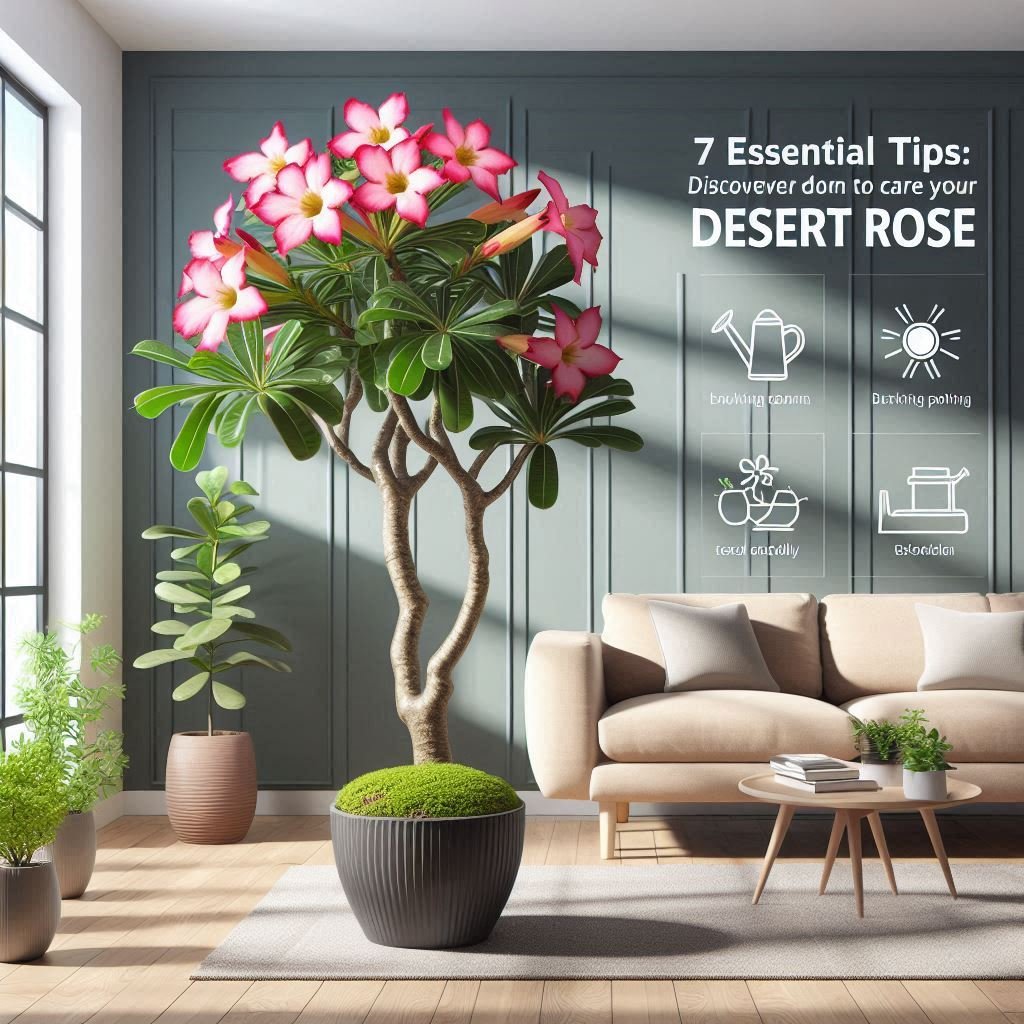
Discovering the Desert Rose
The desert rose plant first caught my eye during a visit to a botanical garden. Its vibrant blooms, resembling delicate roses, stood out amidst the arid landscape, radiating a sense of resilience and beauty. Intrigued by its ability to thrive in such harsh conditions, I knew I wanted to bring a piece of that desert magic into my own home.
My journey with the desert rose truly began when a friend gifted me a small, potted specimen as a birthday present. Named “Sahara,” it quickly became a focal point in my indoor garden. Its thick, succulent leaves and occasional bursts of pink and red flowers transformed my living space into a miniature desert sanctuary.
As I delved deeper into caring for Sahara, I discovered not only its hardy nature but also its unique needs. From ensuring ample sunlight to mastering the art of infrequent watering, each step taught me valuable lessons in nurturing this exotic plant. Today, Sahara continues to thrive, a testament to the joy and wonder that indoor gardening with desert roses brings into my life.
Choosing Your Perfect Desert Rose
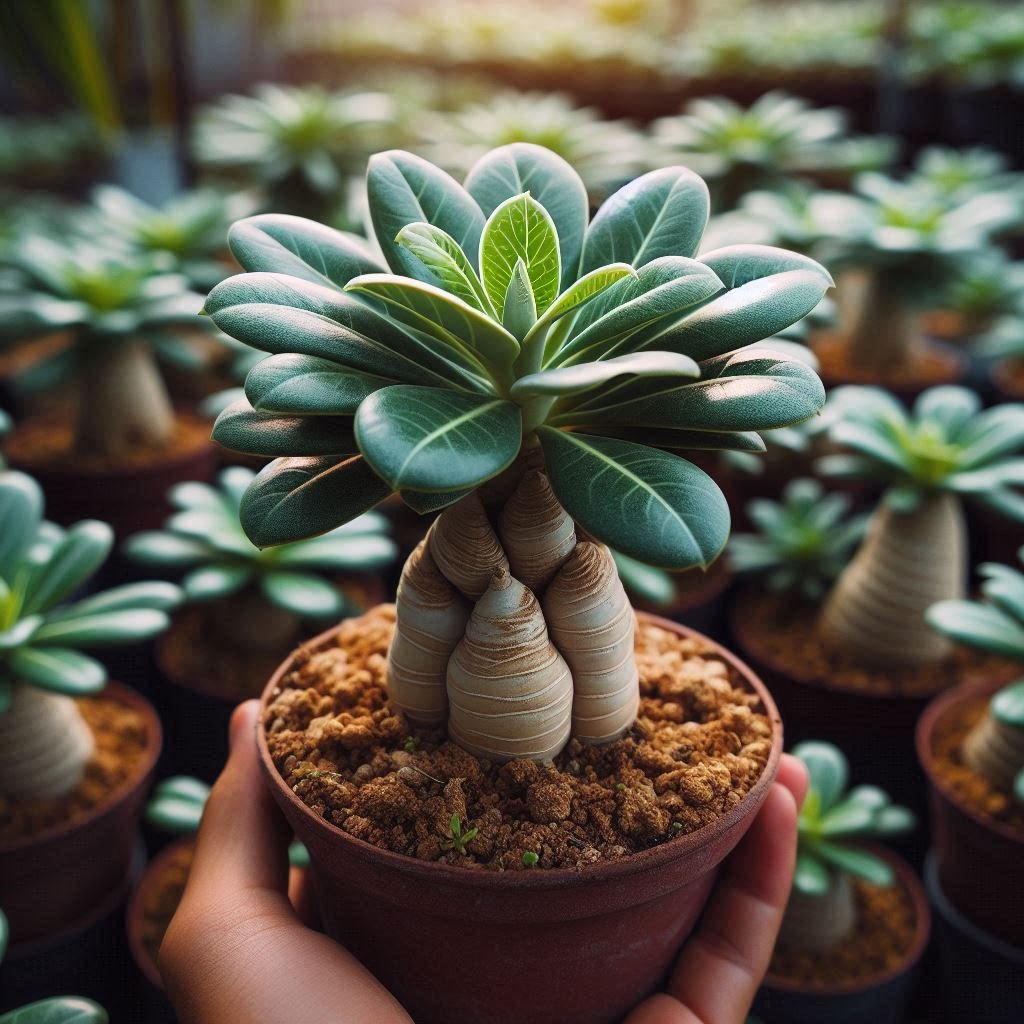
Choosing the right desert rose plant for your indoor garden is an exciting process. Here are essential tips to help you select a healthy plant:
- Inspect the Leaves: Look for firm, glossy leaves that are uniformly green. Avoid plants with yellowing, spots, or discoloration, as these may indicate pests or nutrient deficiencies.
- Check the Stem: Ensure the stem is thick, sturdy, and free from any damage or soft spots. A healthy stem supports the plant’s structure and indicates overall strength.
- Examine the Roots: While fully inspecting roots can be challenging, look for plants with white or light-colored roots. Avoid plants with brown, mushy, or overly dry roots, as these signs suggest poor root health and potential water absorption issues.
- Assess General Appearance: Choose a plant with a compact, bushy shape and balanced growth. Avoid plants that look sparse or have elongated stems, as these may have experienced stress or insufficient care.
- Consider Seasonal Care: If purchasing during colder months, ensure the plant has been shielded from low temperatures during transport and storage. Desert rose plants are sensitive to cold and can be damaged if exposed to chilly conditions.
Personal Story:
My journey to finding the perfect desert rose began unexpectedly. While browsing a local nursery, I stumbled upon a stunning desert rose with deep pink petals and a sturdy, compact shape. Its graceful form and tough nature instantly caught my eye. What really hooked me wasn’t just its beauty but also its reputation for thriving indoors with minimal care.
Bringing this desert rose home felt like adding a touch of desert magic to my indoor space. It surprises me by blooming throughout the year, even when conditions aren’t ideal, making it a beloved centerpiece in my home. Choosing this plant taught me to trust my instincts and appreciate the unique charm each desert rose brings to indoor gardening.
Potting and Soil Selection

Potting your desert rose plant is essential for its health and growth. Here’s how I approached potting and soil selection for my desert rose:
When I first brought my desert rose plant home, I aimed to create the perfect environment for it to thrive. I selected a stylish ceramic pot with adequate drainage holes to ensure the roots wouldn’t sit in water.
For the soil, I opted to create a custom blend that mimicked the sandy, well-draining conditions these plants love. Mixing potting soil with coarse sand and a small amount of perlite helped improve drainage and prevent the roots from becoming waterlogged.
Transferring the plant from its nursery pot to its new home was both exciting and nerve-wracking. Carefully loosening the roots and settling them into the soil mix ensured the plant was stable without being overly compacted.
Initially, I encountered challenges with overwatering due to the soil mix retaining too much moisture. Adjusting the blend by increasing the proportion of sand and perlite significantly improved drainage. This adjustment allowed the roots to breathe better, reducing the risk of root rot.
Now, my desert rose thrives in its new pot, rewarding me with healthy growth and occasional bursts of vibrant blooms. Creating the right potting environment was crucial for my plant’s well-being and added to the beauty of my indoor space.
Watering and Light Balance
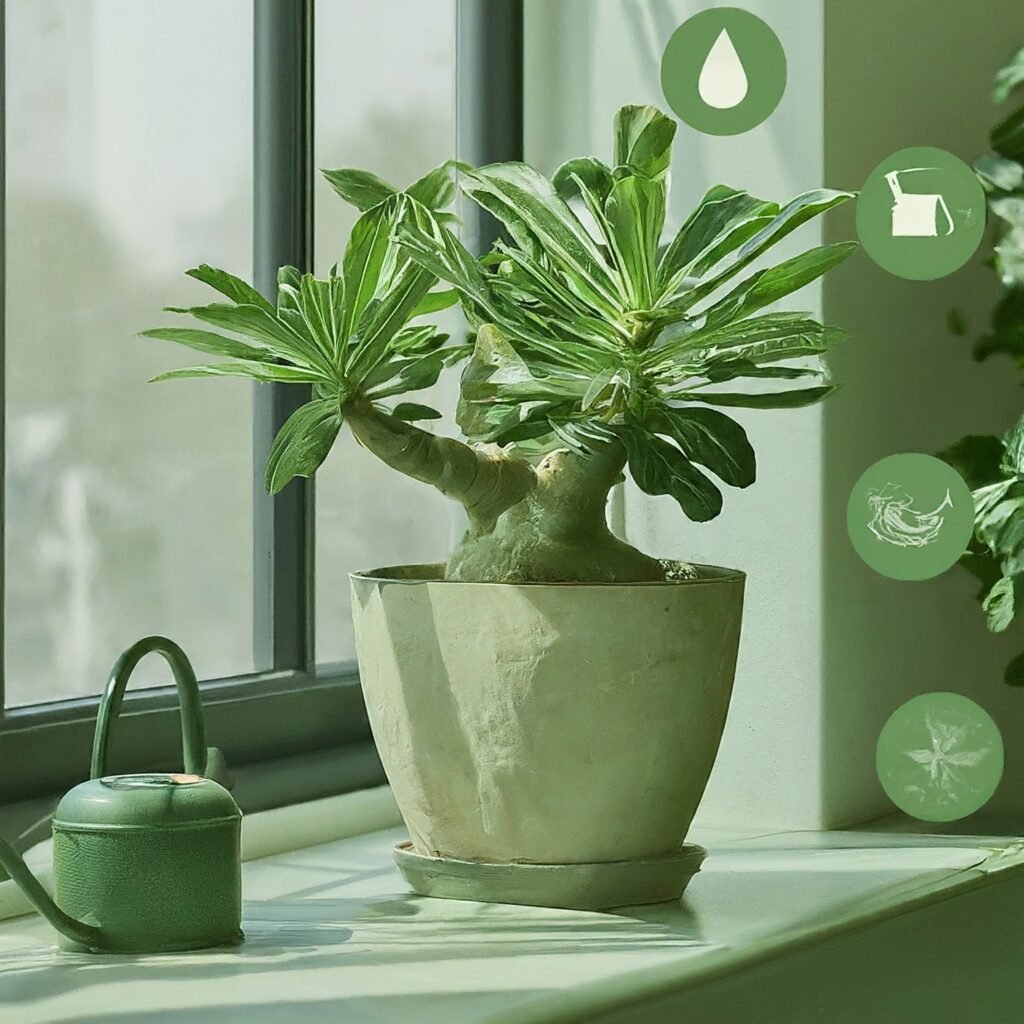
Taking care of my desert rose plant involves finding the right balance of watering and sunlight exposure, perfect for keeping it thriving indoors. Here’s how I manage these essential aspects:
Watering Techniques: When it comes to watering my desert rose, I’ve learned to water deeply but less often. I make sure the soil gets thoroughly moistened, allowing any excess water to drain out through the pot’s bottom. Then, I wait until the top inch or two of soil feels dry before watering again. In winter, I reduce watering to about once every few weeks as the plant slows down.
Light Preferences: My desert rose loves bright, indirect sunlight. I’ve placed it near a sunny window facing south, where it gets plenty of filtered light throughout the day. This spot provides just the right amount of sunlight without exposing the plant to direct afternoon sun, which can be too intense and potentially harm the leaves.
Personal Insights: Finding the right balance of watering and light has been a learning journey. I adjust my watering routine based on how quickly the soil dries in my home, which can vary with the seasons. Observing how my plant responds to different light conditions has been fascinating. It’s amazing to see how it thrives when it gets the perfect amount of sunlight, showing healthy growth and occasional bursts of beautiful blooms.
Fertilizing for Growth
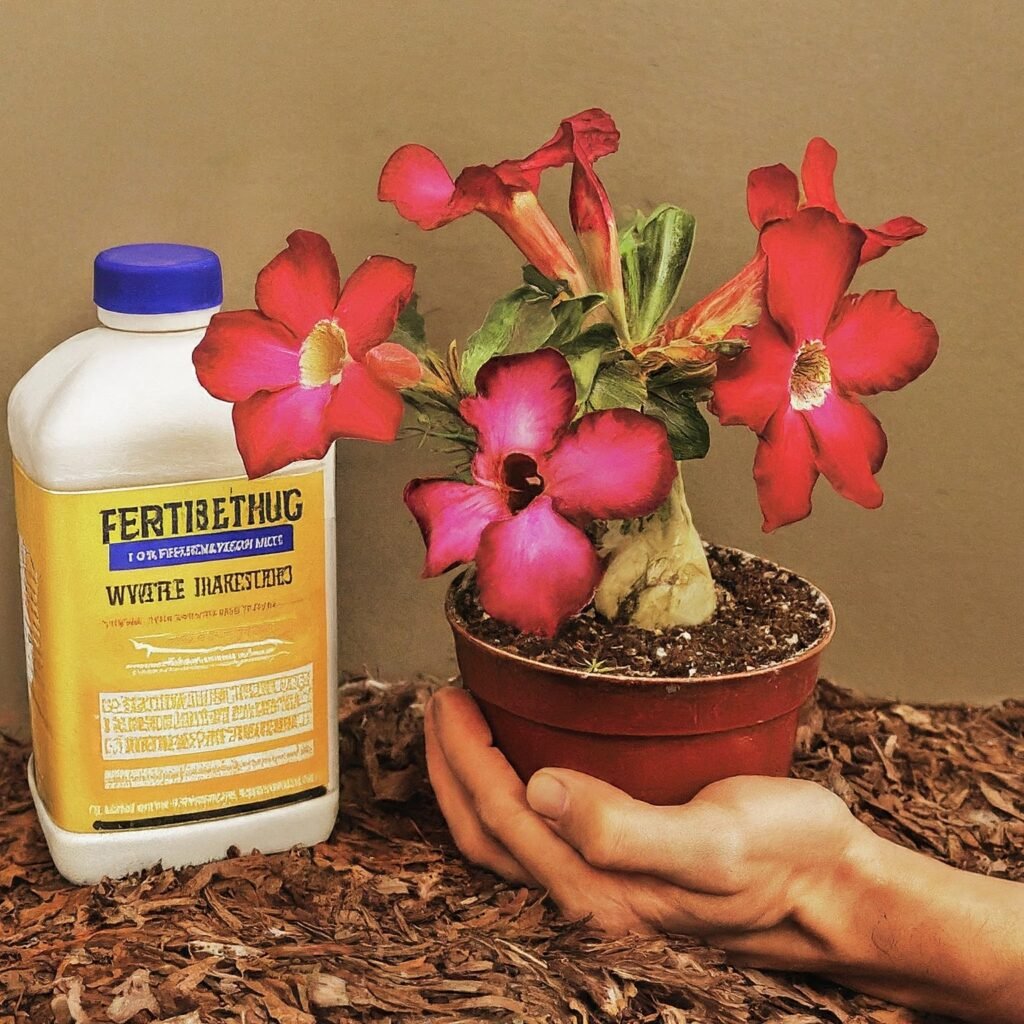
Fertilizing my desert rose plant is essential for ensuring its health and promoting growth indoors. Here’s how I approach fertilizing:
Tips for Fertilizing: Selecting the right fertilizer is crucial. I opt for a balanced, water-soluble fertilizer formulated for flowering plants, diluted to half strength. During the active growing season, typically from spring through early fall, I fertilize my desert rose about every 4-6 weeks. It’s important to withhold fertilizer during the winter months when the plant is dormant.
I apply the fertilizer to damp soil to avoid any potential root burn and carefully follow the manufacturer’s instructions. Desert roses are moderate feeders, so it’s important not to over-fertilize, which can harm the plant.
Easy Pruning and Shaping Tips for Your Desert Rose Plant
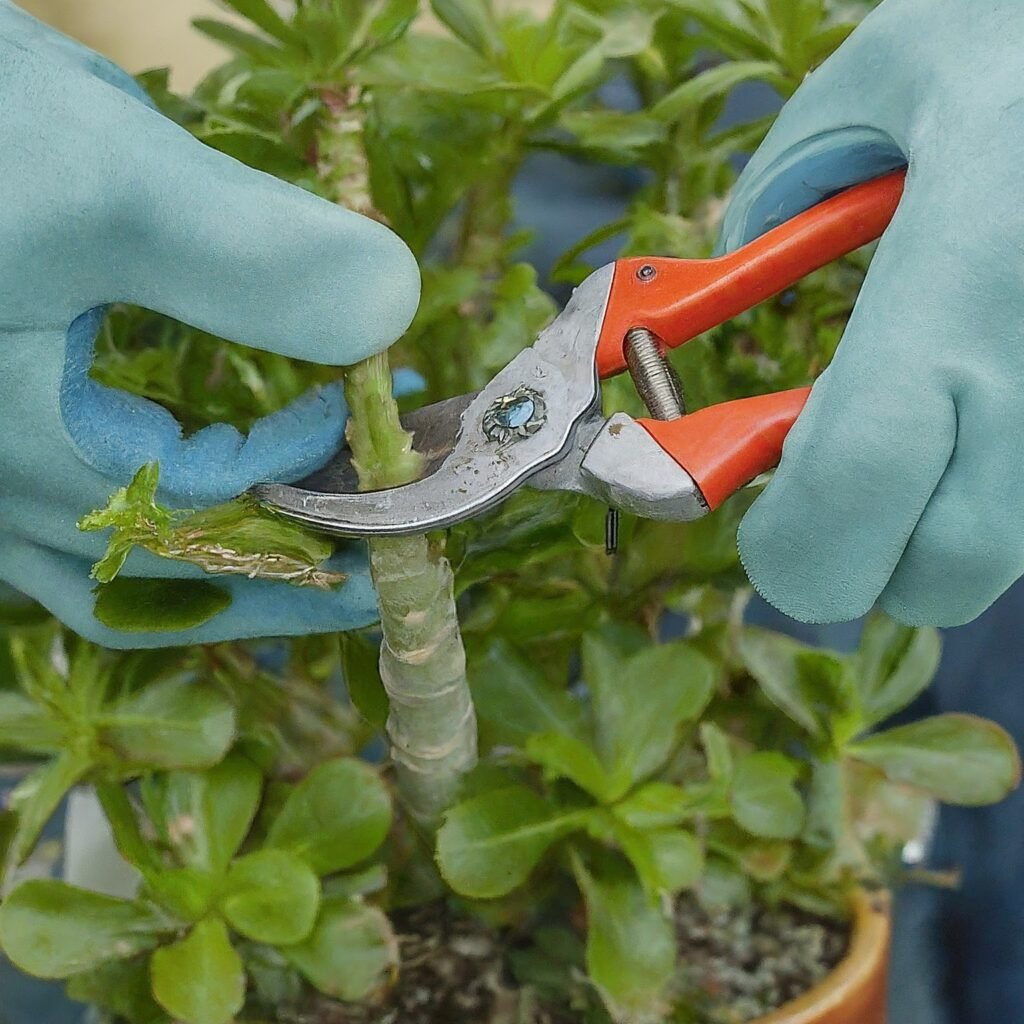
Caring for your indoor desert rose plant involves straightforward yet effective pruning and shaping techniques. Here are practical tips to help maintain its health and appearance:
1. Choose the Right Tools: Start with sharp pruning shears or scissors to make clean cuts without damaging the plant.
2.Trim Dead or Damaged Parts: Regularly inspect your desert rose for any dead or damaged branches. Trim them back to healthy growth to promote new, vibrant growth.
3. Improve Airflow: Thin out crowded areas of leaves to enhance airflow around the plant. This helps prevent diseases and keeps the plant vigorous.
4. Shape Gently: When shaping your desert rose, aim for a balanced and natural appearance. Light pruning after each flowering period helps maintain its shape and encourages more blooms.
5. Monitor Growth and Adjust: Observe how your desert rose responds to pruning. Adjust your trimming schedule based on its growth patterns and seasonal needs, avoiding over-pruning to prevent stress.
Overcoming Challenges: Growing Desert Roses Indoors
Growing desert roses indoors has been an adventure filled with learning and surprises. Managing pesky pests like spider mites became a strategic battle—I’ve learned to combat them with neem oil and a vigilant eye. Dealing with powdery mildew prompted me to improve airflow around the plant and use a plant-friendly fungicidal spray when needed.
Finding the perfect sunlight spot was like solving a puzzle—bright, indirect light near a sunny window seems to keep my desert roses happy and blooming beautifully. Watering was a lesson in patience; they prefer a thorough soak but can’t stand soggy soil, so adding perlite to the potting mix was a game-changer for drainage.
Adapting to their indoor environment meant getting cozy with humidity trays and occasional misting sessions. Despite the challenges, seeing my desert rose thrive indoors has been incredibly rewarding—it’s like watching a miniature desert bloom in my own home.

You have observed very interesting details! ps decent website.Blog money